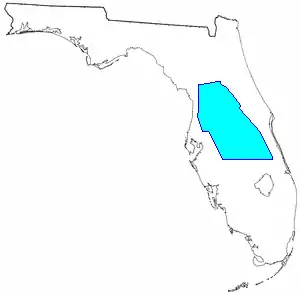 The Treaty of Moultrie Creek established a reservation in central Florida for the Seminoles. | |
| Signed | September 18, 1823 |
|---|---|
| Location | Moultrie Creek[lower-alpha 1] |
| Negotiators | United States and various bands of Native Americans |
The Treaty of Moultrie Creek was an agreement signed in 1823 between the government of the United States and the chiefs of several groups and bands of Indians living in the present-day state of Florida. The treaty established a reservation in the center of the Florida peninsula.
The indigenous peoples of Florida had largely died out by early in the 18th century.[lower-alpha 2] Various groups and bands of Muskogean-speakers (called Creek Indians by the British), Yamasees and Yuchis moved into the area, often with the encouragement of the Spanish colonial government. These groups, which often lived on both sides of the border between Florida and Georgia, came into increasing conflict with white settlers after the United States became independent. When the United States acquired Florida from Spain in 1821 (by means of the Adams-Onís Treaty), the conflict increased. In 1823, the United States government decided to settle the Seminoles on a reservation in the central part of the territory.[4]
A meeting to negotiate a treaty was scheduled for early September 1823 at Moultrie Creek, south of St. Augustine. About 425 Seminoles attended the meeting, choosing Neamathla, a prominent Mikasuki chief, to be their chief representative. Under the terms of the treaty negotiated there, the Seminoles were forced to place themselves under the protection of the United States and to give up all claim to lands in Florida, in exchange for a reservation of about four million acres (16,000 km²).[5]
The reservation ran down the middle of the Florida peninsula from just north of present-day Ocala to a line even with the southern end of Tampa Bay. The boundaries were well inland from both coasts, to prevent contact with traders from Cuba and the Bahamas. Neamathla and five other chiefs, however, were allowed to keep their villages along the Apalachicola River.[6]
Under the Treaty of Moultrie Creek, the United States government was obligated to protect the Seminoles as long as they remained peaceful and law-abiding. The government was supposed to distribute farm implements, cattle and hogs to the Seminoles, compensate them for travel and losses involved in relocating to the reservation, and provide rations for a year, until the Seminoles could plant and harvest new crops. The government was also supposed to pay the tribe US$5,000 a year for twenty years, and provide an interpreter, a school and a blacksmith for the same twenty years. In turn, the Seminoles had to allow roads to be built across the reservation and had to apprehend any runaway slaves or other fugitives and return them to United States jurisdiction.[7]
See also
Notes
- ↑ Moultrie Creek is south of St. Augustine in St. Johns County, Florida[1]
- ↑ The Apalachee, Timucua, and Yustaga of the Spanish mission system in northern Florida were largely killed or carried off to the Province of Carolina by 1706.[2] After the destruction of the Spanish mission system in northern Florida, Yamasees and Muskogean-speakers (called "Creek Indians" by the English, "Uchises" by the Spanish) raided far into the Florida peninsula, killing many of the Florida natives, and capturing others for sale as slaves. Most of the surviving Calusa people retreated to the Florida Keys between 1704 and 1711.[3]
References
- ↑ Willott, Peter (November 28, 2021). "Where History Lives: St. Augustine's rich past runs through Moultrie Creek". St. Augustine Record. Archived from the original on December 15, 2021. Retrieved December 7, 2022.
- ↑ Hoffman, Paul E (2002). Florida's Frontiers. Bloomington, IN: Indiana University Press. p. 180. ISBN 978-0-253-34019-1. OCLC 248260149.
- ↑ Worth, John E. (2012). "Creolization in Southwest Florida: Cuban Fishermen and "Spanish Indians," ca. 1766—1841". Historical Archaeology. 46 (1): 143. Retrieved 3 November 2023.
- ↑ Mahon: 2-8, 18-37
- ↑ Mahon: 40-50
- ↑ Missall: 63-64.
- ↑ Missall: 64-65.
- Mahon, John K. (1985). History of the Second Seminole War 1835–1842 (Revised ed.). Gainesville, Florida: University of Florida Press. ISBN 0-8130-1097-7.
- Missal, John and Mary Lou Missal (2004). Seminole Wars: America's Longest Indian Conflict. Gainesville, Florida: University Press of Florida. ISBN 0-8130-2715-2.